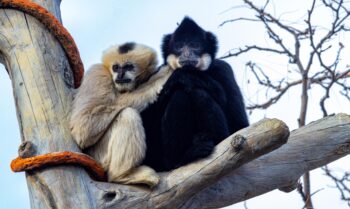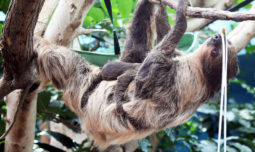April 16, 2019
Denver Zoo Welcomes Baby Sloth
New Baby is the Second Linne’s Two-Toed Sloth to Be Born at the Zoo Since 2018
After what felt like an eternity, our long-awaited Linne’s two-toed sloth baby arrived on Thursday, April 11. Born to Charlotte Greenie, the Zoo’s 23-year-old female sloth, and her 28-year-old mate, Elliot, the new baby, whose name and sex are yet to be determined, has been deemed “very healthy” by our veterinary team. He or she is bonding and resting with Charlotte in their Bird World habitat, while Elliot and older sister Baby Ruth, who was born in January 2018, are temporarily off-exhibit to give mom and baby time and space to bond.
When we announced Charlotte’s pregnancy in December, we estimated that the baby would be born as early as January. However, sloth due dates are notoriously challenging to predict because sloths are primarily active at night and we rarely observe their breeding. Our animal care team closely monitored Charlotte for months to ensure that she and the baby were healthy and gaining the appropriate amount of weight. The baby clung to Charlotte immediately after birth and will remain attached to her almost exclusively for at least six months.
Linne’s two-toed sloths, which are also known as the Linnaeus’s two-toed sloth or southern two-toed sloth, are found in the rainforests of South America, primarily in Venezuela, Columbia, Ecuador, Peru and Brazil. They are a nocturnal species that spend 15 to 20 hours per day sleeping, and become active about an hour after sunset until about two hours before sunrise. Linne’s are among two types of sloths—two-toed and three-toed—and six different species, including the pygmy three-toed, maned, pale-throated, brown-throated, and Hoffman’s. Although the Linnaeus’s two-toed is not currently considered threatened, two other species, the pygmy three-toed and maned, are critically endangered and vulnerable, respectively.
Guests are welcome and encouraged to visit Charlotte and her new baby in their Bird World habitat, but should note that a clear view of the baby might be impaired by foliage or Charlotte’s tight embrace. Keepers say the best time to visit is late in the afternoon when Charlotte is more likely to be moving around, and ask that you keep your voices low while the baby adjusts to life in its new world. Be sure to follow us on Facebook, Twitter and Instagram for regular baby sloth updates!
Subscribe
Be among the first to hear the latest animal updates, important stories and details about all the fun happening around Denver Zoo.
Tags
-
 April 15, 2024
April 15, 2024Good Luck, Chuck!
Good Luck, Chuck! Beloved Bachelor Relocating as Part of Asian Elephant Species Survival Plan In a heartfelt and collaborative…
-
 April 15, 2024
April 15, 2024African Impact
African Impact Two New African Field Conservation ProgramsAim to Protect Gorillas + Grey Crowned Cranes We're honored to provide…
-
 March 1, 2024
March 1, 2024Last Place(s) on Earth
Last Place(s) on Earth New Asian Field Conservation Programs Protect Asian Elephants, Sumatran Orangutans + more Indonesia's Leuser Ecosystem…



